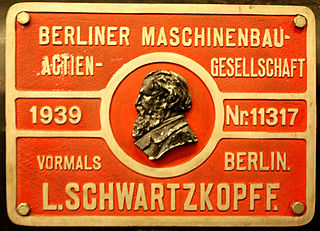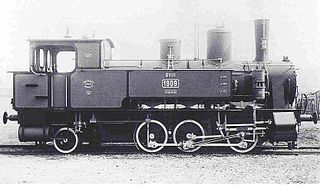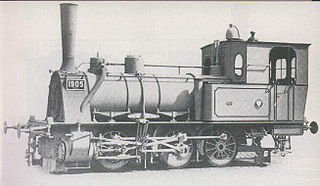
Berliner Maschinenbau AG was a German manufacturer of locomotives.

The Bavarian Class D VIII were saturated steam locomotives with the Royal Bavarian State Railways.

The locomotives of DRG Class 98.10 were superheated steam locomotives with the Deutsche Reichsbahn-Gesellschaft.

A Krauss-Helmholtz bogie (Krauss-Helmholtz-Lenkgestell) is a mechanism used on steam locomotives and some electric locomotives to improve curve running.
The Bavarian Pt 2/4 N was a steam locomotive with the Royal Bavarian State Railways. It was developed in parallel with the Bavarian Pt 2/3 and for the same duties. Instead of a fixed carrying axle it was given a bogie. This change brought no advantage, so the more cost-effective Pt 2/3 was favoured. The two Pt 2/4 N engines were nevertheless taken over by the Reichsbahn, but were retired by 1928.

The German DRG Class 84s were standard goods train tank locomotives with the Deutsche Reichsbahn. A total of twelve engines were placed into service by the Reichsbahn between 1935 and 1937. The machines were given operating numbers 84 001–012. They were worked on the Müglitz Valley Railway (Müglitztalbahn) between Heidenau and Altenberg in the Ore Mountains (Erzgebirge), for which they were specially designed to negotiate tight curves. They were manufactured by the firms of Berliner Maschinenbau and Orenstein & Koppel. One feature was that they were Berliner-built locomotives were fitted with Schwartzkopff-Eckhardt II bogies, while the O&K-built had Luttermöller axles.

The two German DRG Class 61 steam engines were express train locomotives specifically built by Henschel for the Henschel-Wegmann train in service with the Deutsche Reichsbahn. The Henschel-Wegmann train was an initiative of the German locomotive construction industry, intended to be able to demonstrate a powerful steam locomotive-hauled train alongside the emerging express diesel multiple units, such as the Hamburg Flyer.
The German DRG Class 71.0 was a 2-4-2T locomotive with the Deutsche Reichsbahn, which was intended as a replacement for railbuses. Originally it had been planned for these standard engines (Einheitsloks) to haul fast passenger trains.

The German Class 99.73-76 engines were standard locomotives (Einheitslokomotiven) in service with the Deutsche Reichsbahn for Saxony's narrow gauge railways. Together with their follow-on class, the DR Class 99.77-79, they were the most powerful narrow gauge locomotives in Germany for the 750 mm track gauge.

The Württemberg T 3s were German steam locomotives with the Royal Württemberg State Railways delivered between 1891 and 1913.

The engines of DR Class 99.23 are metre gauge tank locomotives, that were procured by the Deutsche Reichsbahn (DR) in East Germany from 1954 to 1956. When they entered service they had operating numbers 99 231–99 247. Today they are numbered 99 7231–99 7247.

The Mecklenburg T 4 was a German steam locomotive built for the Grand Duchy of Mecklenburg Friedrich-Franz Railway as a goods train 2-6-0T with a leading axle and three coupled axles. In 1925 it was incorporated in the renumbering plan of the Deutsche Reichsbahn as DRG Class 91.19.
The Saxon Class XVIII was a German six-coupled tender locomotive built for the Royal Saxon State Railways in 1917/18 for express train services. The Deutsche Reichsbahn grouped them in 1925 into DRG Class 18.0.
The Prussian G 5.4 was a German goods train locomotive with a compound engine. Due to its top speed of 65 km/h it was also used on passenger services. The G 5.4, like the G 5.3, differed from the G 5.1 and G 5.2 in having a shorter wheelbase and higher boiler pitch. In addition, the Krauss-Helmholtz bogies enabled its riding qualities to be improved, especially at higher speeds. Between 1901 and 1910 a total of about 760 vehicles of the Class G 5.4 were built for the Prussian state railways. The last 25 locomotives were fitted once again with an Adams axle.

The Prussian Class T 11 were passenger tank locomotives produced between 1903 and 1910 in the service of the Prussian state railways for duties on the Berlin Stadtbahn.

The Prussian Class T 3 steam locomotives procured for the Prussian state railways were 0-6-0 tank locomotives. Together with the Prussian T 2 they were the first locomotives that were built to railway norms. The first units were delivered by Henschel in 1882.
Friedrich Wilhelm Eckhardt was a German engineer and head of the design office for the Berliner Maschinenbau Aktien Gesellschaft vormals L. Schwartzkopff.

The Prussian T 8 were six-coupled superheated goods tank locomotives of the Prussian state railways. They were originally intended for suburban passenger service in Berlin, and for use on branch lines. Due to their poor running qualities, they were demoted to shunting and short-distance goods train service.
The Royal Saxon State Railway designated four-coupled tank locomotives for passenger train service as class IV T (four-T), and the Deutsche Reichsbahn subsequently grouped these locomotives into DRG Class 71.3 in 1925.

The Prussian G 7.3 was a class of 2-8-0 locomotives of the Prussian state railways. The third class of the G 7 series, they were intended to power heavy goods trains on steep inclines, on which the permissible axle load was not yet that high. This affected for example, the Paderborn–Holzminden and Betzdorf–Siegen routes.














